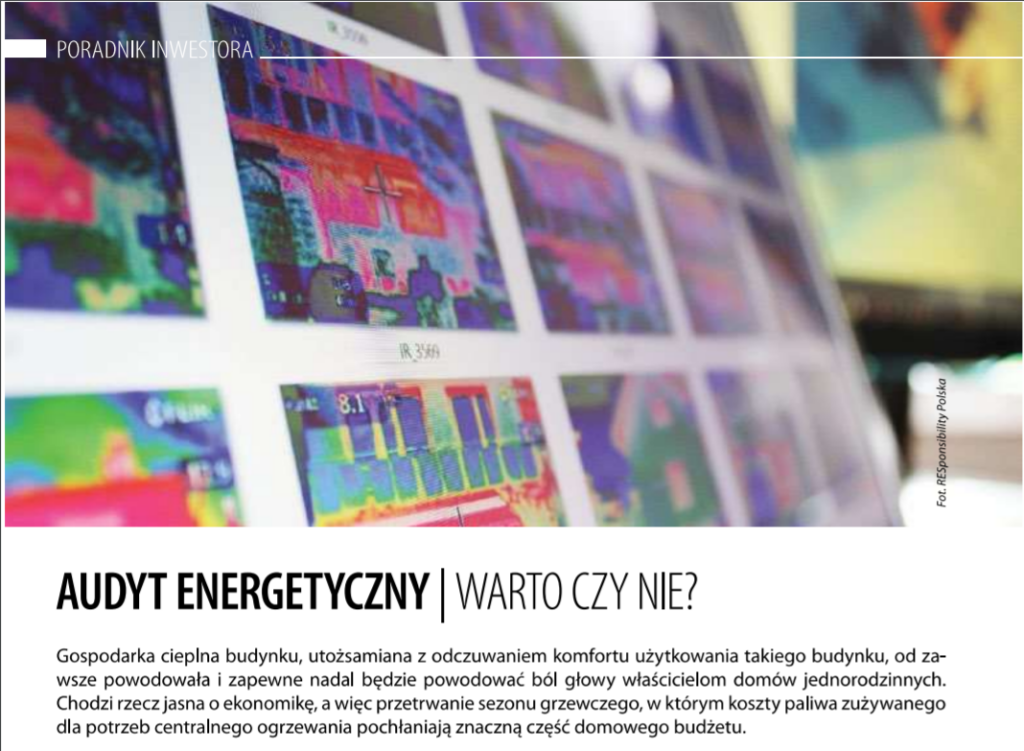Thermal management of the building, identified with the feeling of comfort of its use, has always caused and probably still will cause a headache to proprietors of family hauses. Of course, this is about beeing economical, or – to be more precise – simply survive till the end of the heating season, during which the costs of fuel used for central heating consume a significant part of the family budget.
On one hand we have the exploitation costs, on the other hand – there are possibilities to minimalize it, but simultaneously increese investment cost to thermomodernization of a building. But how much time will it take to regain invested money? How much money can be saved from reducing the need for heating? The precise answer for those questions provides us the energy audit.
Is energy audit unavoidable before thermomodernization work? No, it is not, because the companies taking care of heating the buildings will execute their tasks anyway, receiving accurate reward from the investor. However, will they do their job properly? In most cases presumably – yes, perhaps all of the thermal bridges will be destroyed, styrofoam will be glued peripherally and the drilled holes in the wall will have been cleaned before studding. All of the above will prove possible provided the company we hired is solid and dependable. Yet the main concern is still left unanswered – taking action without the energy audit remains an unsure task.
WHAT IS AN ENERGY AUDIT?
The energy audit is a report describing in a precise way the range, technical as well as economical parameters of a potential venture, which containing recomendations on optimal solutions from the economic standpoint (incurred investment outlays to the obtained effects achived in a given period). Such report, along with a declaration of optimal variant, are simultaneously the main aspects of thermomodernization project. The energy audit can be defined as a sistematic procedure allowing to gain knowledge about the profile of utilization of energy in the building as well as to set a plan of economically profitable actions, which will consequently lead to specific savings.
The understanding the essence of audit, when it comes to the proprietors or users of the buildings, ought to come from the distincion between the use of energy and its possible maximum level. It is the result of taking certain actions in order to improve the energy effitiency. The main part of the energy auditor is to provide extensive and sufficient knowledge about how and with which technology it is possible to achieve this goal.
LOCAL PROSPECT
The role of the energy auditor is to evaluate the actual state of the building. Such action cannot be conducted during a phone call or based merely on a project. The local visitation is indispensible! Rarely does the real state of the building reflect the contents of its project. It is, above all, the result of the alterations made throughout the construction process (which does not require changes in the project), oftentimes made in hopes to save some amount of the investor’s money, e.g. by replacing some building materials. Another matter are the adaptations introduced by the users in the course of expoitation of the building. The examples are numerous, from the changing of door and window woodwork to alterations in previously predicted function of several rooms. Therefore, the responsibility of the auditor is to personally see the building and to interview the investor. Thus, if someone offers an audit in 24 hours, through the telephone or email, it would be advisable to consider if behind this lower price is in fact the service we expect.
EVALUATION OF THE BUILDING AND PROPOSITIONS OF CHANGES
The exectution of the energy audit primerly focuses on the analisis of: the parameters and the technical state of the building (based on the construction project, local prospect, thermovisual examination etc.), the building’s energy characteristics (the need for heating, the use of energy, heating power, the price of the tariffs), heating system characteristics (the type and parameters of the instalation, the choice of radiators, the use of particular installation elements) and installation of heated water. Also, equally important are the characteristics of the appliances in the building, such as: boiler room or thermal centre, system of ventilation, gas installation and chimney conductors.
Gathering all of the data above, in a precise and meticulous way, it allows to correctly carry out vital calculations of the building’s heat demand. Only then will we be able to appropiately approach the subject of thermomodernization of the building, putting forth solid alternatives of improvement and ventures, beneficial from the investor’s viewpoint (according to the ordinance of the Minister of the Infrastructure and Development from 27th February 2015 concerning the methodology of preparing the building’s energy characteristics and the certificate of energy characteristics).
Gathering and analizing the data through the building’s energy demand allows to estimate the use of energy in a standard heating season (based on the balance sheet of the profit and loss/forfeiture of the heat, including the ventilation), as well as the avarage cost of the heating in the heating season, which is the starting point of proposed thermomodernization actions. Obviously, the role of the auditor is to verify the accurance of interpretation of accepted calculations based on the data.
As the result of these calculations, the numerous variants of building heating are put forward. The first in the line and natural action is to increase heating of the inner wall, then ceiling heating (below the unheated attic) and replacement of the window woodwork. It should be borne in mind that that one of the thermomodernization actions would also be the exchange of the heating source and modernization of the central heating installation, along with hot usable water. There is no point in presenting more detailed description of the mentioned actions, since each one of them has its own specification and aspects, all worthy of attention. This is also the reason why taking advantage of the knowledge and experience of the auditor is highly advisable. While not every investor has to be an expert in building construction or ventilation systems, every energy auditor most definitely should.
SUMMARY
The effect of conducting the energy audit is to propose possible undertakings, the result of which will be to increase the energy efficiency of the building, to reduce energy consumption and, consequently, cost for heating and domestic hot water preparation.
Answering the question if it is worth it to take advantage of energy audit – yes, it is. Without a doubt it is an additional cost for the investor who decides to thermomodernizate the building. Nevertheless, this is an investment in the knowledge of the construction of the buillding we live in, as well as the comfort of making a right decision concerning thermomodernization, keeping in mind the questions of energy, economy and – as to what is currently crucial – ecology. Another advantage, although it should not be connected with energy audit, is the possibility of aquiring the certificate of energy characteristics, essential in case of selling or renting the property.
The world is changing, the technical conditions of new buildings are increasingly rigoristic but one thing remains the same – we all want our home to be warm. Not only is thermomodernization a way to improve our comfort but its also the mean to reduce exploitation costs. However, for it to produce expected results, the thermomodernization must be conducted in a proper way and without the audit, it would be barely possible.
Author: Dr inż. Michał Kaczmarczyk, RESponsibility Polska













